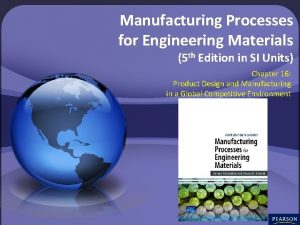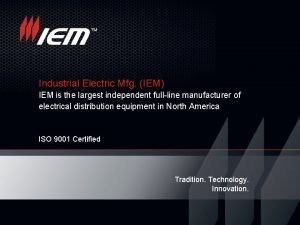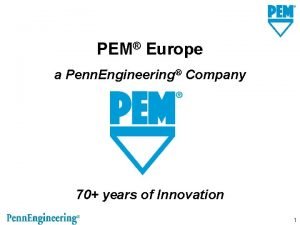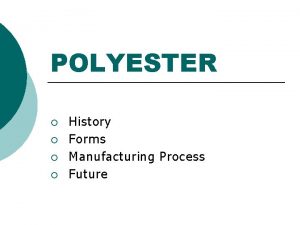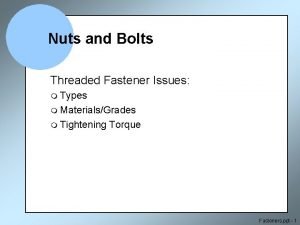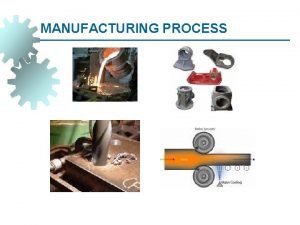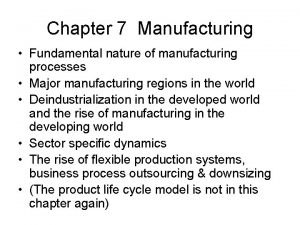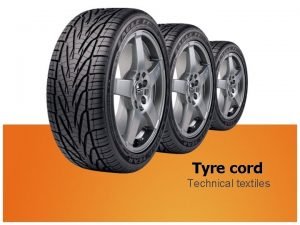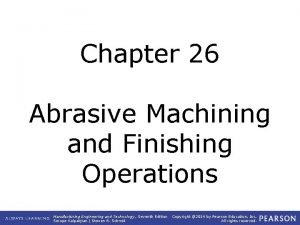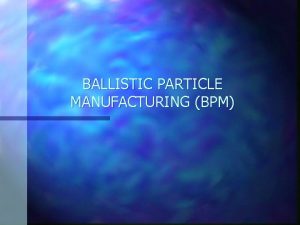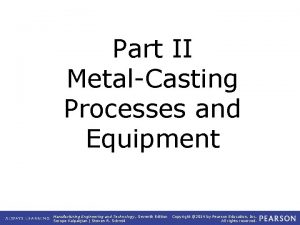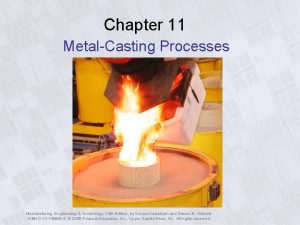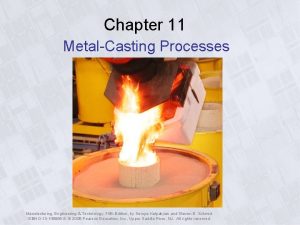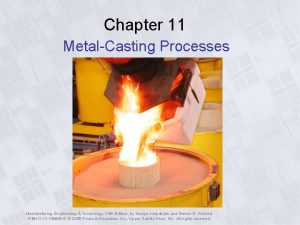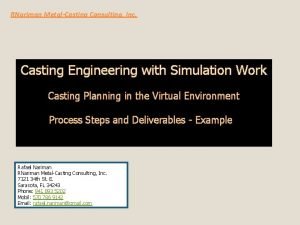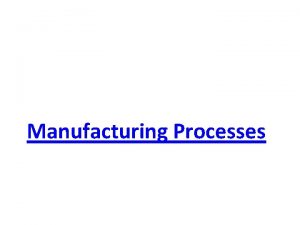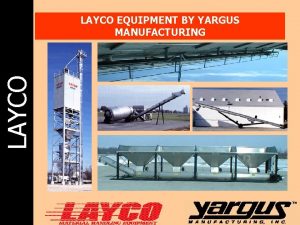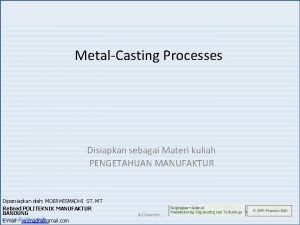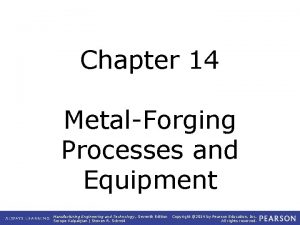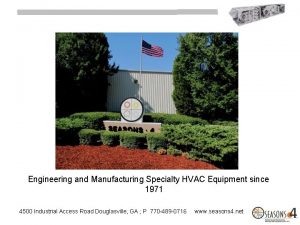Chapter 11 MetalCasting Process and Equipment Manufacturing Engineering






















- Slides: 22

Chapter 11 Metal-Casting Process and Equipment Manufacturing Engineering and Technology , Seventh Edition Serope Kalpakjian | Steven R. Schmid Copyright © 2014 by Pearson Education, Inc. All rights reserved.

FIGURE 11. 1 (a) Typical gray-iron castings used in automobiles, including the transmission valve body (left) and the hub rotor with disk-brake cylinder (front). Source: Courtesy of Central Foundry Division of General Motors Corporation. (b) Die-cast magnesium housing for the Olympus E-3 camera; Source: Courtesy of Olympus Inc. (c) A cast transmission housing. (d) Cast aluminum impellers for automotive turbochargers. Source: (c) and (d) Courtesy of American Foundry Society. Manufacturing Engineering and Technology , Seventh Edition Serope Kalpakjian | Steven R. Schmid Copyright © 2014 by Pearson Education, Inc. All rights reserved.

FIGURE 11. 2 Outline of production steps in a typical sand-casting operation. Manufacturing Engineering and Technology , Seventh Edition Serope Kalpakjian | Steven R. Schmid Copyright © 2014 by Pearson Education, Inc. All rights reserved.

SAND MOLD Manufacturing Engineering and Technology , Seventh Edition Serope Kalpakjian | Steven R. Schmid Copyright © 2014 by Pearson Education, Inc. All rights reserved.

TYPES OF MOLDS 1. Expendable mold 2. Permanent mold 3. Composite mold Manufacturing Engineering and Technology , Seventh Edition Serope Kalpakjian | Steven R. Schmid Copyright © 2014 by Pearson Education, Inc. All rights reserved.

FIGURE 11. 3 Schematic illustration of a sand mold, showing various features. Manufacturing Engineering and Technology , Seventh Edition Serope Kalpakjian | Steven R. Schmid Copyright © 2014 by Pearson Education, Inc. All rights reserved.

PATTERNS Manufacturing Engineering and Technology , Seventh Edition Serope Kalpakjian | Steven R. Schmid Copyright © 2014 by Pearson Education, Inc. All rights reserved.

FIGURE 11. 4 A typical metal match-plate pattern used in sand casting. Manufacturing Engineering and Technology , Seventh Edition Serope Kalpakjian | Steven R. Schmid Copyright © 2014 by Pearson Education, Inc. All rights reserved.

PATTERN DESIGN Should allow for 1. Metal shrinkage 2. Proper metal flow in the mold cavity 3. Easy removal from sand mold (draft) Manufacturing Engineering and Technology , Seventh Edition Serope Kalpakjian | Steven R. Schmid Copyright © 2014 by Pearson Education, Inc. All rights reserved.

FIGURE 11. 5 Taper on patterns for ease of removal from the sand mold. Manufacturing Engineering and Technology , Seventh Edition Serope Kalpakjian | Steven R. Schmid Copyright © 2014 by Pearson Education, Inc. All rights reserved.

CORES used to form the interior surfaces of the casting and are then removed Core prints are used to locate and support the core Chaplets (metal supports) are used to anchor the support in place Manufacturing Engineering and Technology , Seventh Edition Serope Kalpakjian | Steven R. Schmid Copyright © 2014 by Pearson Education, Inc. All rights reserved.

FIGURE 11. 6 Examples of sand cores, showing core prints and chaplets to support the cores. Manufacturing Engineering and Technology , Seventh Edition Serope Kalpakjian | Steven R. Schmid Copyright © 2014 by Pearson Education, Inc. All rights reserved.

FIGURE 11. 7 Vertical flaskless molding. (a) Sand is squeezed between two halves of the pattern. (b) Assembled molds pass along an assembly line for pouring. (c) A photograph of a vertical flaskless molding line. Source: Courtesy of American Foundry Society. Manufacturing Engineering and Technology , Seventh Edition Serope Kalpakjian | Steven R. Schmid Copyright © 2014 by Pearson Education, Inc. All rights reserved.

FIGURE 11. 8 The vacuum molding process. (a) A plastic sheet is thermoformed (see Section 19. 6) over a pattern; (b) a vacuum flask is placed over the pattern, a pouring basin/sprue insert is located, and the flask is filled with sand. A second sheet is located on the top of the sand mold, and vacuum is applied to tightly compact the sand against the pattern. (c) A drag is also produced, along with cheeks, cores, etc. , as in conventional sand casting; the cope and drag can be carefully transported without vacuum applied. (d) After the mold halves are joined, vacuum is applied to ensure mold strength, and molten metal is poured into the mold. Manufacturing Engineering and Technology , Seventh Edition Serope Kalpakjian | Steven R. Schmid Copyright © 2014 by Pearson Education, Inc. All rights reserved.

FIGURE 11. 9 Schematic illustration of the sequence of operations for sand casting. (a) A mechanical drawing of the part is used to generate a design for the pattern. Considerations such as part shrinkage and draft must be built into the drawing. (b) and (c) Patterns have been mounted on plates equipped with pins for alignment; note the presence of core prints designed to hold the core in place. (d) and (e) Core boxes produce core halves, which are pasted together; the cores will be used to produce the hollow area of the part shown in (a). (f) The cope half of the mold is assembled by securing the cope pattern plate to the flask with aligning pins and attaching inserts to form the sprue and risers. (g) The flask is rammed with sand, and the plate and inserts are removed. (h) The drag half is produced in a similar manner with the pattern inserted; a bottom board is placed below the drag and aligned with pins. (i) The pattern, flask, and bottom board are inverted, and the pattern is withdrawn, leaving the appropriate imprint. (j) The core is set in place within the drag cavity. (k) The mold is closed by placing the cope on top of the drag and securing the assembly with pins; the flasks are then subjected to pressure to counteract buoyant forces in the liquid, which might lift the cope. (l) After the metal solidifies, the casting is removed from the mold. (m) The sprue and risers are cut off and recycled, and the casting is cleaned, inspected, and heat treated (when necessary). Source: Courtesy of Steel Founders’ Society of America. Manufacturing Engineering and Technology , Seventh Edition Serope Kalpakjian | Steven R. Schmid Copyright © 2014 by Pearson Education, Inc. All rights reserved.

FIGURE 11. 9 (continued) Schematic illustration of the sequence of operations for sand casting. (a) A mechanical drawing of the part is used to generate a design for the pattern. Considerations such as part shrinkage and draft must be built into the drawing. (b) and (c) Patterns have been mounted on plates equipped with pins for alignment; note the presence of core prints designed to hold the core in place. (d) and (e) Core boxes produce core halves, which are pasted together; the cores will be used to produce the hollow area of the part shown in (a). (f) The cope half of the mold is assembled by securing the cope pattern plate to the flask with aligning pins and attaching inserts to form the sprue and risers. (g) The flask is rammed with sand, and the plate and inserts are removed. (h) The drag half is produced in a similar manner with the pattern inserted; a bottom board is placed below the drag and aligned with pins. (i) The pattern, flask, and bottom board are inverted, and the pattern is withdrawn, leaving the appropriate imprint. (j) The core is set in place within the drag cavity. (k) The mold is closed by placing the cope on top of the drag and securing the assembly with pins; the flasks are then subjected to pressure to counteract buoyant forces in the liquid, which might lift the cope. (l) After the metal solidifies, the casting is removed from the mold. (m) The sprue and risers are cut off and recycled, and the casting is cleaned, inspected, and heat treated (when necessary). Source: Courtesy of Steel Founders’ Society of America. Manufacturing Engineering and Technology , Seventh Edition Serope Kalpakjian | Steven R. Schmid Copyright © 2014 by Pearson Education, Inc. All rights reserved.

FIGURE 11. 9 (continued) Schematic illustration of the sequence of operations for sand casting. (a) A mechanical drawing of the part is used to generate a design for the pattern. Considerations such as part shrinkage and draft must be built into the drawing. (b) and (c) Patterns have been mounted on plates equipped with pins for alignment; note the presence of core prints designed to hold the core in place. (d) and (e) Core boxes produce core halves, which are pasted together; the cores will be used to produce the hollow area of the part shown in (a). (f) The cope half of the mold is assembled by securing the cope pattern plate to the flask with aligning pins and attaching inserts to form the sprue and risers. (g) The flask is rammed with sand, and the plate and inserts are removed. (h) The drag half is produced in a similar manner with the pattern inserted; a bottom board is placed below the drag and aligned with pins. (i) The pattern, flask, and bottom board are inverted, and the pattern is withdrawn, leaving the appropriate imprint. (j) The core is set in place within the drag cavity. (k) The mold is closed by placing the cope on top of the drag and securing the assembly with pins; the flasks are then subjected to pressure to counteract buoyant forces in the liquid, which might lift the cope. (l) After the metal solidifies, the casting is removed from the mold. (m) The sprue and risers are cut off and recycled, and the casting is cleaned, inspected, and heat treated (when necessary). Source: Courtesy of Steel Founders’ Society of America. Manufacturing Engineering and Technology , Seventh Edition Serope Kalpakjian | Steven R. Schmid Copyright © 2014 by Pearson Education, Inc. All rights reserved.

FIGURE 11. 13 (a) Metal is poured into a mold for lost-foam casting of a 40 -hp, three-cylinder marine engine; (b) finished engine block; and (c) completed outboard motor. Source: Mercury Marine. Manufacturing Engineering and Technology , Seventh Edition Serope Kalpakjian | Steven R. Schmid Copyright © 2014 by Pearson Education, Inc. All rights reserved.

FIGURE 11. 22 Various types of cavities in a die-casting die. Source: Images provided by: North American Die Casting Association, Wheeling, Illinois. Manufacturing Engineering and Technology , Seventh Edition Serope Kalpakjian | Steven R. Schmid Copyright © 2014 by Pearson Education, Inc. All rights reserved.

FIGURE 11. 24 (a) Schematic illustration of the centrifugal-casting process; pipes, cylinder liners, and similarly shaped parts can be cast with this process. (b) Side view of the machine. Manufacturing Engineering and Technology , Seventh Edition Serope Kalpakjian | Steven R. Schmid Copyright © 2014 by Pearson Education, Inc. All rights reserved.

MELTING FURNACES 1. Electric furnaces 2. Induction furnaces 3. Crucible furnaces 4. Cupolas Manufacturing Engineering and Technology , Seventh Edition Serope Kalpakjian | Steven R. Schmid Copyright © 2014 by Pearson Education, Inc. All rights reserved.

FIGURE 11. 30 Two types of melting furnaces used in foundries. Manufacturing Engineering and Technology , Seventh Edition Serope Kalpakjian | Steven R. Schmid Copyright © 2014 by Pearson Education, Inc. All rights reserved.
 Manufacturing processes for engineering materials 5th
Manufacturing processes for engineering materials 5th Manufacturing cost vs non manufacturing cost
Manufacturing cost vs non manufacturing cost Manufacturing cost vs non manufacturing cost
Manufacturing cost vs non manufacturing cost Controllable costs
Controllable costs Manufacturing cost vs non manufacturing cost
Manufacturing cost vs non manufacturing cost Additive manufacturing steps
Additive manufacturing steps Equipment name
Equipment name Iem industrial equipment manufacturing ltd
Iem industrial equipment manufacturing ltd Penn engineering & manufacturing corp.
Penn engineering & manufacturing corp. Qsoft capsule
Qsoft capsule Manufacturing process of polyester
Manufacturing process of polyester Types of fasteners ppt
Types of fasteners ppt Factory sintering gear
Factory sintering gear Manufacturing operations can be classified into
Manufacturing operations can be classified into Flow diagram cheese production flow chart
Flow diagram cheese production flow chart Defination of tools
Defination of tools Nature of manufacturing process
Nature of manufacturing process Tyre manufacturing process
Tyre manufacturing process Tyre cords
Tyre cords Oracle discrete manufacturing process flow
Oracle discrete manufacturing process flow Abrasive machining and finishing operations
Abrasive machining and finishing operations Discrete manufacturing bpm
Discrete manufacturing bpm Secondary process manufacturing definition
Secondary process manufacturing definition
